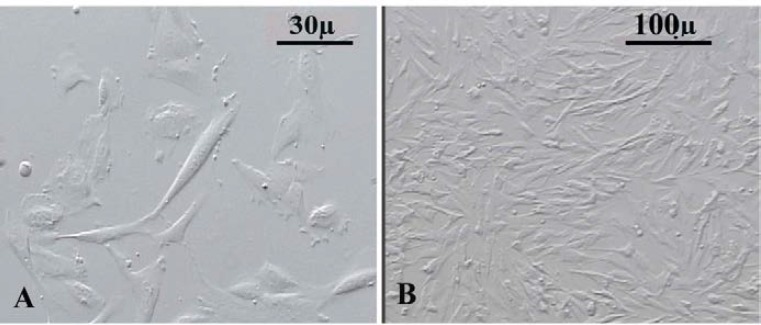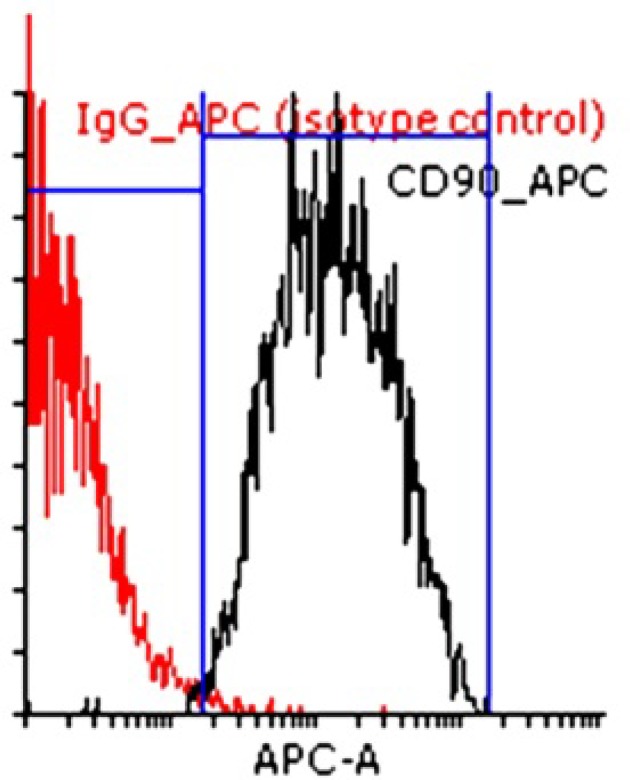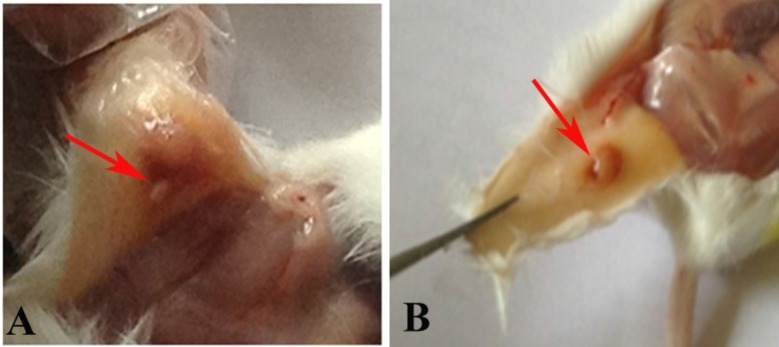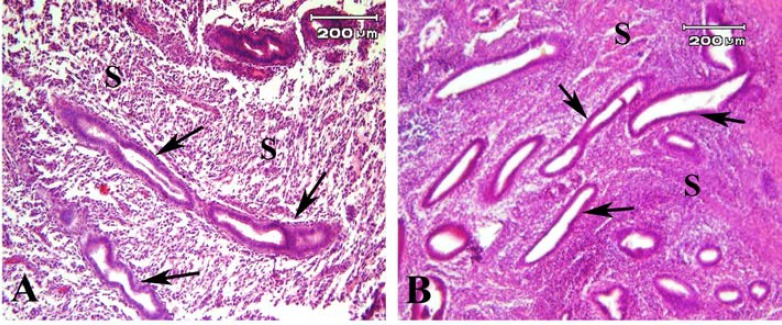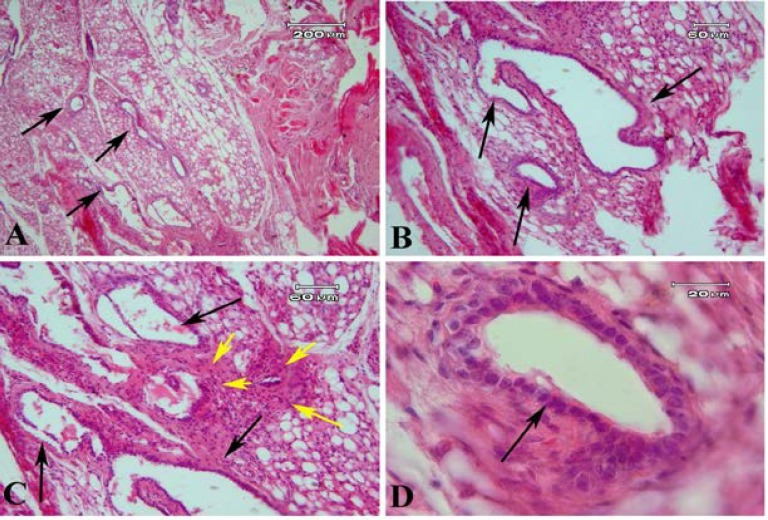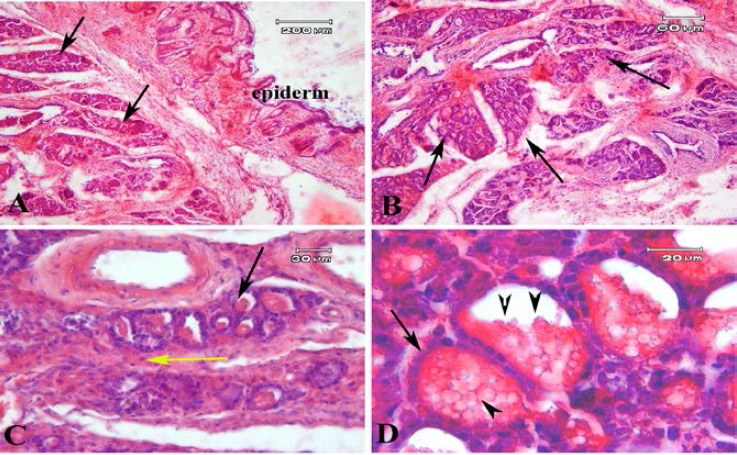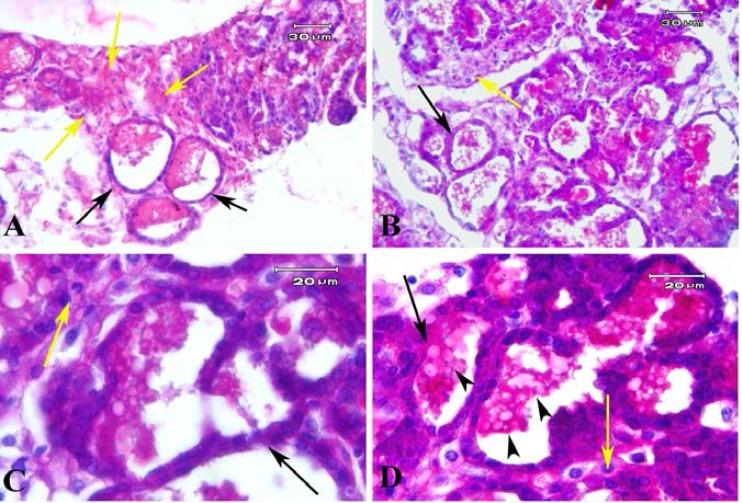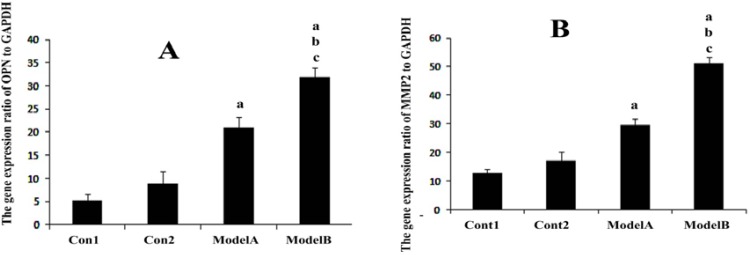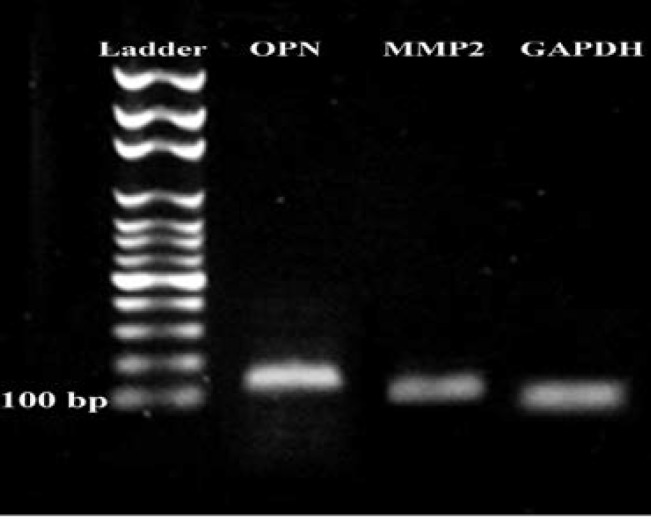Abstract
Background:
The animal models of endometriosis could be a valuable alternative tool for clarifying the etiology of endometriosis.
Objective:
In this study two endometriosis models at the morphological and molecular levels was evaluated and compared.
Materials and Methods:
The human endometrial tissues were cut into small fragments then they were randomly considered for transplantation into γ irradiated mice as model A; or they were isolated and cultured up to fourth passages. 2×106 cultured stromal cells were transplanted into γ irradiated mice subcutaneously as model B. twenty days later the ectopic tissues in both models were studied morphologically by Periodic acid-Schiff and hematoxylin and eosin staining. The expression of osteopontin (OPN) and matrix metalloproteinase 2 (MMP2) genes were also assessed using real time RT-PCR. 17-β estradiol levels of mice sera were compared before and after transplantation.
Results:
The endometrial like glands and stromal cells were formed in the implanted subcutaneous tissue of both endometriosis models. The gland sections per cubic millimeter, the expression of OPN and MMP2 genes and the level of 17-β estradiol were higher in model B than model A (p=0.03).
Conclusion:
Our observation demonstrated that endometrial mesenchymal stromal cells showed more efficiency to establish endometriosis model than human endometrial tissue fragments.
Key Words: Endometriosis, Matrix metalloproteinase 2, Osteopontin, Stromal cells
Introduction
Endometriosis (EMs) is a common gynecological disorder, which is characterized by abdominal pain, dysmenorrhea, infertility and irregular menstruation (1). It is an estrogen-dependent disease and recognized by the presence of endometrial tissue including endometrial glands and stromal cells outside the uterus (2). Some methods were proposed for treatment of EMs; however its pathogenesis has not yet been fully understood (3-6). Several studies have been focused on the establishment of endometriosis models, and showed that human endometrial tissue could be successfully transplanted into ectopic sites of animal models (7-11).
In homologous models of endometriosis, the endometrial tissue is removed and cut into small pieces then reintroduced into the peritoneal cavity of the same animal, whereas heterologous model has been developed by implanting human endometrial fragments from different phases of the menstrual cycle into immunodeficient mice (7, 8). The recovered transplanted tissue forms endometriotic-like lesions which their macroscopic and histological appearance were similar to those found in endometriosis patients. Heterologous models are very useful for understanding the mechanisms involved in the establishment of endometriosis as well as therapeutic testing of pharmacological and hormonal modulations (10-12). Pelch et al reported that the mouse model of surgically-induced endometriosis appears to be a good model for studying the pathophysiology and treatment of endometriosis (13).
The transplanted endometrial tissue has the ability of attachment and invasion to the host tissue through involvement of some intrinsic factors (14-17). Adhesion and invasion of endometrial tissue contribute both cell-to-cell and cell-to-matrix interactions which are mediated by adhesive molecules such as osteopontin (OPN) and proteolytic enzymes including matrix metalloproteinase (MMPs) (18, 19). OPN and MMPs are glycoproteins that are expressed in the human endometrium during implantation window as the best-characterized endometrial receptivity biomarkers (20, 21). OPN, a 70-kDa secretory glycoprotein, is mainly involved in cell adhesion and migration and binds to various integrin molecules as its receptors (18, 19, 22).
The MMPs are belong to a family of proteins called the zinc metalloproteinase and involved in the endometrial shedding during menstruation and tumor invasion (23-25). The expression of MMPs in human endometrial tissue changes during different phases of menstrual cycle (26). Moreover several authors have studied the endometrial expression of OPN and MMPs in endometriosis patients with controversial results (27-30). One of the suggested mechanisms for impaired implantation in endometriosis patients is that abnormal expression of OPN and MMPs by eutopic endometrial tissues (31).
The existence of adult stem cells in endometrial tissue has been proved and these stem cells can be identified by the clonogenicity property, side population and expression of stem cell markers (32-34). It is proposed that endometrial stem cells are involved in etiology of endometriosis (35-37). In agreement with this hypothesis, there are some reports which demonstrated the potential of endometrial stem cells to produce endometriosis lesion after transplantation under kidney capsules of immunodeficient mice (38, 39).
The animal models of endometriosis could be a valuable alternative tool for clarifying the etiology of endometriosis (10). According to the best of our knowledge, there is a few information regarding to the establishment of endometriosis model using ectopic transplantation of endometrial stromal cell. There are some similarities between the endometrial stem cells and mesenchymal stem cells of other tissues like bone marrow (40), thus in the present study we mainly focused on the CD90 positive cells as a known mesenchymal stem cell marker. CD90 was used as a marker to identify the mesenchymal stem cells within the endometrial tissues by others (41-44). The immunophenotypes of these endometrial cells were analyzed using flow cytometry and their ability to differentiation to adipogenic and osteogenic, neural progenitors and glial-like cells were reported previously by our group (45, 46).
Thus the aim of the present study was to compare two endometriosis models by transplantation of human endometrial mesenchymal cells (CD90+) in comparison with human endometrial fragments to γ irradiated mice. These two models were evaluated by analysis of OPN and MMP2 genes expression in ectopic lesion and level 17-β estradiol in sera of mice.
Materials and methods
Unless otherwise stated, all the chemicals and reagents used for this study were purchased from Sigma Aldrich (Germany).
Human endometrial samples
In this experimental study, the human endometrial samples from non-pathological women with aged 30-45 years (n=6) were obtained. These women had not used any hormonal treatment for three months prior to tissue removal. The tissues were transported to laboratory in Dulbecco Modified Eagle Medium /Hams F-12 (DMEM/F-12; Invitrogen, UK) containing 100 µg/ml penicillin G sodium, 100 µg/ml streptomycin sulphate B (Invitrogen, UK) and 5% fetal bovine serum (FBS; Invitrogen, UK) at 4oC.
Then, they were cut into small fragments (2×2×2 mm3) and considered randomly for further analysis. One fragment of each biopsy randomly was fixed in 4% buffered formaldehyde and embedded in paraffin wax for histological study. The normal morphology of the tissue was evaluated under light microscopy by experienced histopathologist. The samples in the proliferative phase had chosen for all experiments. Some fragments of each biopsy were considered for isolation and culturing of endometrial cells and the remaining tissue fragments were used for transplantation and molecular analysis.
Isolation and culture of human endometrial stromal cells
The preparation of endometrial cells was according to the method of Gargett et al (44). Endometrial tissue (n=6 biopsy samples) was washed three times with phosphate buffered saline (PBS), transferred to DMEM supplemented with 10% FBS, and cut into 1-2 mm3 fragments for each sample.
The specimens were digested and dissociated into single-cell using 300 µg/ml collagenase type 3, 40 µg/ml deoxyribonuclease type I (DNAase I) for 60-90 min at 37oC in 5% CO2. Then, the tissue was filtered through sterile meshes of 150, 100, 40 sieve (BD Biosciences) respectively (45). The collected endometrial stromal cells were resuspended with DMEM/F12 with10% FBS, and cultured in a six-well plate at 37oC in 5% CO2 and the media was changed every 2-3 days.
Flow cytometric analysis of cultured human endometrial stromal cells
The immunophenotype of cultured endometrial stromal cells at fourth passage were assessed by CD90 marker as mesenchymal stem cell markers using flow cytometric analysis. Cultured endometrial cells trypsinized and plated at a density of 2×105 cells/cm2 in DMEM medium containing 5% FBS. The cells were resuspended in 100 μl of PBS and incubated with direct APC-conjugated antibody (CD90) (1:100 dilutions) at 4oC for 1 hr. The labeled cells were washed in 100 μl of PBS and examined with a Flow Cytometric Calibur apparatus (FACS; Becton Dickinson).
Preparation of γ-irradiated mice
Female National Medical Research Institute (NMRI) mice (6-8-weeks-old) with 20±1 gr weight were kept in university laboratory animal's house. The mice were treated with a single dose of 7.5 Gy γ-irradiation for 6 min 72 hr later the tissue and cells transplantation were performed in model A and B of endometriosis respectively (47).
The mice at prostrous phase were considered for transplantation (n=16 for all groups of study). Prior to transplantation, vaginal smears were prepared to prove the phases of mouse estrus cycle. The mice were anesthetized by an intraperitoneal injection of a mixture of 75 mg/kg body weight ketamine 10% and 15mg/kg xylazine 2% before transplantation under sterile conditions. All housing materials, as well as food and water, were autoclaved prior to use.
Transplantation of endometrial tissue and mesenchymal stem cells to mice
The mice at prostrous phase (n=6 for each group) were considered for transplantation in two groups of study as follows: In model A) the mice were received 3 pieces of endometrial tissue fragments (1-2 mm3) subcutaneously on one side of gluteal region via a dorso-horizontal incision then the wound was closed. In model B) the endometrial cells were harvested by 0.05% trypsin digestion and washed three times with PBS at the end of fourth passage.
Approximately 20 µL of endometrial cell suspension which containing 2×106 cells was injected by an insulin syringe subcutaneously on the one side of gluteal region via a dorso-horizontal incision then the wound was closed (48). Transplanted mice were maintained under sterile conditions for 20 days. Then the mice were sacrificed and the endometrial lesions were collected and randomly fixed for light microscopic study or kept at -80ºC for molecular analysis.
Light Microscopic study
Human endometrial fragments before transplantation as control (n=6) and tissue lesion in two endometriosis models (n=3 for each group) were fixed in 10% formalin and embedded in paraffin wax. Tissue sections were prepared serially at 5 μm thickness and every fifth section of each sample was mounted on a glass slide and stained with hematoxylin and eosin and observed under light microscope with 100 magnification. In each tissue section, three fields of microscope were considered for evaluation of gland sections.
The photos of each section were prepared and imported into Image J software. The area of each section was measured in units of pixels and converted to millimeters based on the conversion determined by measuring the image of the calibrated millimeter then the mean number of glands per mm2 was counted in each sample. For study of gland secretion another set of paraffin embedded tissue sections was prepared and mounted on a glass slide and stained with Periodic acid-Schiff (PAS) reaction and observed under the light microscope.
Hormonal assay
Prior to mouse tissue sampling at prostrous phase, the blood samples were collected from the heart apex of mice then their sera were separated and kept at -20oC until hormonal analysis (n=6 for each model). The sera of non-transplanted mice (n=4) at prostrous phase were collected and considered as control. The concentrations of 17-β estradiol of sera were measured by an enzyme-linked immunosorbent assay kit (ELISA; Monobind, USA, sensitivity=6.5 pg/ml).
RNA extraction and cDNA synthesis
The mRNA levels of two endometriosis-related genes including OPN and MMP2 to housekeeping gene (GAPDH) were analyzed and compared in normal human endometrial tissue (before transplantation as control 1), human endometrial stromal cells (control 2) and endometriosis lesions derived from two endometriosis models (n=3 in each model).
RNA extraction was performed using an RNeasy MiniKit (Qiagen, Valencia, CA, USA), according to the manufacturer’s instructions. Using oligo dT, RNA was reverse-transcribed by Revert Aid M-MuL V reverse transcriptase using specified primers. Primers were synthesized based on human mRNA coding sequences. GAPDH gene was used as an internal control. The primers for real-time RT-PCR were designed using GenBank (http://www.ncbi.nlm.nih.gov) and Allele ID software (Table I) and ordered and synthesized by CinnaGen Co. (Iran, Tehran).
Table I.
Oligonucleotide primer sequences for real time RT-PCR
| Primer Name | CG% | Tm | Primer sequence | Length (bp) |
|---|---|---|---|---|
| OPN (SPP1)F | 55 | 58.1 | 5'- AGACCTGACATCCTGTACCC-3' | 189 |
| OPN (SPP1)R | 57.89 | 58.4 | 5'- GTCGGTTTCAGCACTCTGG-3' | |
| MMP2F | 55 | 57.5 | 5'- CGGCGAACCCATACTTCACA -3' | 151 |
| MMP2R | 55 | 57.3 | 5'- GGCGAACGATACCCCTTTGA-3' | |
| GAPDH F | 62.3 | 58 | 5'- CTGGGCTACACTGAGCACC-3' | 101 |
| GAPDH R | 52.4 | 58 | 5'-AAGTGGTCGTTGAGGGCAATG-3' |
Real Time RT-PCR
The real time RT-PCR was done by QuantiTect SYBR Green RT-PCR kit (Applied Biosystems, UK) after CDNA synthesis. The GAPDH was considered as reference gene and were amplified with the target genes in the same run. Real time thermal condition was including holding step: 95oC, 5', cycling step: 95oC 15', 58oC 30', 72oC 30' and it was continued by a melt curve step: 95oC 15', 60oC 1', 95oC 15'. Then the expression of the genes were analyzed by Pfaffel method. These experiments were done at least in three times.
Ethical consideration
This study was approved by the ethics committee of medical faculty of Tarbiat Modares University (Ref no=52/11224). Informed written consent was obtained from each woman.
Statistical analysis
Statistical analysis was done with SPSS software (Statistical Package for the Social Sciences, version 19.0, SPSS Inc, Chicago, Illinois, USA). Quantitative variables were expressed as means±SD. The mean number of glands per mm2 and the results of the real time RT-PCR were compared by one-way ANOVA and the post hoc Tukey test. Mean hormone levels were compared using independent samples student’s t-test. P≤0.05 was considered significant.
Results
The morphology of cultured human endometrial cells
After 24 hr some cells were adhered to the floor of plate and the population of these cells were heterogeneous in appearance (Figure 1A). After 3-4 passages, these cells became morphologically similar (Figure 1B).
Figure 1.
Phase contrast imaging of cultured human endometrial cells at first passage (A) and fourth passage (B).
The proportion of CD90+ endometrial stromal cells using flow cytometry
The immunophenotype of cultured endometrial stromal cells at the end of fourth passage revealed that the rates of CD90+ cells was 94.98±3 (Figure 2) in three repetitions.
Figure 2.
Flow cytometric analysis of CD90+ cultured endometrial stromal cells at the end of fourth passage. The histogram is the representative of three independent experiments. The red line shows the isotype control.
The gross morphology of endometriosis lesion
The macroscopic observation of endometriosis lesions in two models were shown in the Figure 3. As the figure showed. these lesions had cystic morphology and clearly was distinguished from the surrounding tissues.
Figure 3.
The gross morphology of endometriosis lesions in model A (A) and model B (B). As the arrow shows the lesions have cystic morphology
Light microscopy observation
The morphology of human endometrial tissue before transplantation was normal and consists of a single layer of columnar epithelium at the surface and glandular portion (Figure 4 A, B). The representative light microscopic micrograph of transplanted endometrial tissue fragments which stained with H&E in model A is shown in Figure 5. The recovered endometriosis lesions firmly attached to underlying tissue. Photomicrograph of tissue sections of lesion demonstrated the presence of endometrial glands within the subcutaneous tissue. The flattened stromal cells with eosinophilic cytoplasm were seen between gland sections (Figure 5C).
Figure 4.
Light microscopy of normal human endometrial tissue were observed (A &B), the endometrial glands (black arrow) with stromal tissue (S) were seen
Figure 5.
The morphology of recovered endometriosis lesion obtained from γ-irradiated mice stained by hematoxylin and eosin in model A. The black arrows indicate the endometrial like glands within the subcutaneous tissue of mice with low (A) and high magnification (B-D). The yellow arrows show the stromal cells between glands like sections
Some large cysts like glands which were lined by low columnar epithelial cells were seen (Figure 5 B, C). The tissue morphology of endometriosis lesion in model B were similar to model A and is presented in Figure 6. However, the endometrial like glands sections were prominent in subcutaneous tissue in model B compared to model A. These gland like structures were lined with cuboidal epithelium. Some eosinophilic secretions were seen within the lumen of these glands (Figure 6 C, D). The mean number of gland sections per mm2 in model A (57.55±17.18) was significantly lower than model B (271.57±77.98; p=0.03). The endometrial like gland structures within tissue sections of endometriosis lesions in both models showed positive reaction for Periodic acid-Schiff reaction (Figure 7). Also the stromal like cells within the gland sections showed the PAS positive reaction.
Figure 6.
The representative photomicrographs of recovered endometriosis lesion stained by hematoxylin and eosin in model B. A lot of gland sections are seen within the subcutaneous tissue (black arrow) and these gland like sections are prominent in model B with low magnification (A & B) and higher magnification (C & D). Yellow arrow head shows the stromal cells between gland sections with high magnification (C). The black arrow head shows the eosinophilic secretion within these gland like structure (D).
Figure 7.
Photomicrograph of endometriosis lesions in model B stained with PAS method. It demonstrated the endometrial like glands which lined with cuboidal epithelial cells (black arrows) and PAS positive secretion within them (black arrow heads). The stromal cells between gland sections show the PAS positive reaction (yellow arrow
Hormonal assay
The level of 17-β estradiol in sera of mouse endometriosis model A and B and normal non-transplanted mice were 49.22±1.48, 63.32±1.71 and 40.05±0.83 pg/ml respectively (Table II). The level of 17-β estradiol was significantly increased in model B compared to model A and it was significantly higher in both models than the control group (p=0.03).
Table ІІ.
The level of 17-β estradiol in sera of all studied groups
: significant differences with control (normal mouse sera) group (p<0.05) .
: significant differences with Model A (p<0.05).
OPN and MMP2 gene expression
The data regarding to gene expression are summarized and compared in Figure 8. The expression ratio of OPN and MMP2 to housekeeping gene in both recovered transplanted samples (endometriosis models A, B) was higher than the control 1 and control 2 (p=0.03) and these expression ratios in ectopic tissue in model B was higher than the model A (p=0.03). The gel electrophoresis of real time RT-PCR product is shown in Figure 9.
Figure 8.
The expression ratio of OPN and MMP2 to GAPDH gene in normal endometrium as control1 and CD90+ mesenchymal stromal cells as control2 and in endometrial lesion in model A and model B. a: Significant differences with control1; b: Significant differences with control2; c: Statistically difference with model A (p=0.03
Figure 9.
The gel electrophoresis of real time RT-PCR product. The ladder was 100bp. OPN: osteopontin; MMP2: metalloproteinase 2; GAPDH as internal control
Discussion
In this study we compared the potential of endometrial tissue fragments and isolated endometrial stromal cells to induce endometriosis lesions in mice. Our results demonstrated that in both models the endometrial like gland was formed. The PAS positive secretion was confirmed the nature of these glands which was similar to human endometriosis lesion.
Moreover, this study, for the first time, showed that CD90+ endometrial cultured cells had the potential to create ectopic lesion of endometriosis after transplantation into mouse. The characteristics of these cells were demonstrated previously by our group using flow cytometric analysis (45, 46). These cells were positive for mesenchymal markers (CD90, CD105, CD146) and negative for epithelial (CD9) and hematopoietic (CD31, CD34) markers (45). The efficiency of gland formation in endometrial stromal cells induced model was better than the conventional model using fragment transplantation. One explanation for this observation may be the higher purification of mesenchymal CD90+ cells in cellular model (B). As their flow cytometric analysis confirmed that almost 95% of cultured cells at the end of fourth passage were CD90 positive. So it could be suggested that the proliferation of the mesenchymal stromal cells is involved in manifestation and pathogenesis of endometriosis. Other investigators also reported similar observation by transplantation of endometrial stem cells under kidney capsule of immunodeficient mice (38, 39).
We demonstrated that the level of 17-β estradiol was higher in both models compared to control group however model B produced significantly higher amounts. One explanation for this observation may be the increased glandular tissue formation in model B. Indeed, the estrogen dependence of endometriosis tissue was confirmed in several studies (2, 49). It was shown that the ectopic endometriotic tissue has high aromatase activity and this enzyme is responsible for the conversion of androstenedione and testosterone to estrone and estradiol. So the endometriosis implants can make estrogens from androgens by the aromatase enzyme (50). Our results confirmed the increased production of 17-β estradiol in both endometriosis models similar to human endometriosis patients.
We also revealed that OPN and MMP2 mRNA levels were increased in endometriotic lesions in both endometriosis models in comparison with normal tissue however the expression of OPN and MMPs gene was higher in model B compared to the model A. Our findings on OPN gene expression are in agreement with other reports which have demonstrated an increase in OPN expression in a rat model of endometriosis in comparison to normal rats endometrial tissue and in patients with endometriosis in comparison with control subjects (28, 51-53). According to the functional role of OPN in cell adhesion, migration, differentiation and invasion of tumor cells, it could be assumed that OPN enhance endometrial invasiveness, proliferation and survival in ectopic lesions in animal models. Similar to our findings, Jiao et al using RT-PCR and western blotting, demonstrated that the expression levels of MMP2 and MMP9 were significantly increased in the rats endometriosis models compared to normal rats tissue (52).
"Recently Malvezzi et al reported that the level of MMP2 is significantly higher in serum of infertile women with advanced stages of endometriosis (29)". "Pelch et al also showed that the expression of genes associated with the extracellular matrix, cell adhesions, immune function, cell growth, and angiogenesis are altered in the endometriotic lesion compared to the eutopic uterus (13)". An increased level of OPN and MMP mRNA in endometriosis models may be related to high concentration of estrogen. Wang and Ma evaluated the effects of estrogen and progestin on expression of MMP2 and tissue inhibitor of MMP2 in a nude mouse model of endometriosis and showed that estrogen can raise the expression level of MMP2 to promote ectopic implantation of endometrial tissue (43).
However, our findings support the idea that OPN and MMP may play a role in the pathogenesis of endometriosis, we suggest that it may be involved in attachment and invasion of the endometrium to ectopic sites. The presented model by our group shares some advantages described for the heterologous model using transplanting of human endometrial tissue into immunodeficient mice, such as availability and low costs, however, it also provides a promising tool not only for experimental approaches evaluating the etiology of endometriosis regarding to the type of responsible stem cells but also for therapeutic testing of pharmacological and hormonal modulations based on human endometrial stem cell however, judgment about its complete applications needs more investigations.
Conclusion
In conclusion, our observation demonstrated that endometrial CD90+ mesenchymal stromal cells showed more efficiency to establish endometriosis model human endometrial tissue fragments.
Acknowledgments
The authors thank to Mr. Pour-Beiranvand for his technical help. This research was supported by Tarbiat Modares University.
Note
This article extracted from M.Sc. thesis. (Rana Sadafi)
Conflict of interest
The authors report no conflicts of interest. The authors alone are responsible for the content and writing of the paper. None of the authors are directly funded by or employed by the Government of Iran.
References
- 1.Burney RO, Giudice LC. Pathogenesis and pathophysiology of endometriosis. Fertil Steril. 2012;98:511–519. doi: 10.1016/j.fertnstert.2012.06.029. [DOI] [PMC free article] [PubMed] [Google Scholar]
- 2.Bulun SE, Yang S, Fang Z, Gurates B, Tamura M, Sebastian S. Estrogen production and metabolism in endometriosis. Ann N Y Acad Sci. 2002;955:75–85. doi: 10.1111/j.1749-6632.2002.tb02767.x. [DOI] [PubMed] [Google Scholar]
- 3.Abu Hashim H. Potential role of aromatase inhibitors in the treatment of endometriosis. Int J Womens Health. 2014;6:671–680. doi: 10.2147/IJWH.S34684. [DOI] [PMC free article] [PubMed] [Google Scholar]
- 4.Platteeuw L, D'Hooghe T. Novel agents for the medical treatment of endometriosis. Curr Opin Obstet Gynecol. 2014;26:243–252. doi: 10.1097/GCO.0000000000000084. [DOI] [PubMed] [Google Scholar]
- 5.Felix Wong WS, Danforn Lim CE. Hormonal treatment for endometriosis associated pelvic pain. Iran J Reprod Med. 2011;9:163–170. [PMC free article] [PubMed] [Google Scholar]
- 6.Ghahiri A, Najafian A, Ghasemi M, Najafian A. Comparison study on effectiveness of pentoxifyllin with LD to prevent recurrent endometriosis. Iran J Reprod Med. 2012;10:219–222. [PMC free article] [PubMed] [Google Scholar]
- 7.Edwards AK, Nakamura DS, Virani S, Wessels JM, Tayade C. Animal models for anti-angiogenic therapy in endometriosis. J Reprod Immunol. 2013;97:85–94. doi: 10.1016/j.jri.2012.10.012. [DOI] [PubMed] [Google Scholar]
- 8.Bruner-Tran KL, Webster-Clair D, Osteen KG. Experimental endometriosis: the nude mouse as a xenographic host. Ann N Y Acad Sci. 2002;955:328–339. doi: 10.1111/j.1749-6632.2002.tb02793.x. [DOI] [PubMed] [Google Scholar]
- 9.Colette S, Defrere S, Lousse JC, Van Langendonckt A, Loumaye E, Donnez J. Evaluation of estrogen treatment in an immunodeficient mouse endometriosis model. Gynecol Obstetric Invest. 2009;68:262–268. doi: 10.1159/000240672. [DOI] [PubMed] [Google Scholar]
- 10.Grummer R. Animal models in endometriosis research. Hum Reprod Update. 2006;12:641–649. doi: 10.1093/humupd/dml026. [DOI] [PubMed] [Google Scholar]
- 11.Mohammadzadeh A, Heidari M, Soltan Ghoraii H, Zarnani AM, Ghaffari Novin M, Akhondi M, et al. Induction of Endometriosis by implantation of endometrial fragments in female rats. Iran J Reprod Med. 2006;4:2. [Google Scholar]
- 12.Tirado-Gonzalez I, Barrientos G, Tariverdian N, Arck PC, Garcia MG, Klapp BF, et al. Endometriosis research: animal models for the study of a complex disease. J Reprod Immunol. 2010;86:141–147. doi: 10.1016/j.jri.2010.05.001. [DOI] [PubMed] [Google Scholar]
- 13.Pelch KE, Schroder AL, Kimball PA, Sharpe-Timms KL, Davis JW, Nagel SC. Aberrant gene expression profile in a mouse model of endometriosis mirrors that observed in women. Fertil Steril. 2010;93:1615–1627. doi: 10.1016/j.fertnstert.2009.03.086. [DOI] [PMC free article] [PubMed] [Google Scholar]
- 14.Agic A, von Wussow U, Starzinski-Powitz A, Diedrich K, Altevogt P, Hornung D. Inhibition of cell proliferation, adhesion, and invasion with an anti-L1-cell adhesion molecule monoclonal antibody in an in vitro endometriosis model. Fertil Steril. 2010;94:1102–1104. doi: 10.1016/j.fertnstert.2009.11.050. [DOI] [PubMed] [Google Scholar]
- 15.Delbandi AA, Mahmoudi M, Shervin A, Akbari E, Jeddi-Tehrani M, Sankian M, et al. Eutopic and ectopic stromal cells from patients with endometriosis exhibit differential invasive, adhesive, and proliferative behavior. Fertil Steril. 2013;100:761–769. doi: 10.1016/j.fertnstert.2013.04.041. [DOI] [PubMed] [Google Scholar]
- 16.Young VJ, Brown JK, Maybin J, Saunders PT, Duncan WC, Horne AW. Transforming growth factor-beta induced Warburg-like metabolic reprogramming may underpin the development of peritoneal endometriosis. J Clin Endocrinol Metab. 2014;99:3450–3459. doi: 10.1210/jc.2014-1026. [DOI] [PMC free article] [PubMed] [Google Scholar]
- 17.Silveira CG, Finas D, Hunold P, Koster F, Stroschein K, Canny GO, et al. L1 cell adhesion molecule as a potential therapeutic target in murine models of endometriosis using a monoclonal antibody approach. PloS One. 2013;8:e82512. doi: 10.1371/journal.pone.0082512. [DOI] [PMC free article] [PubMed] [Google Scholar]
- 18.Lessey BA, Damjanovich L, Coutifaris C, Castelbaum A, Albelda SM, Buck CA. Integrin adhesion molecules in the human endometrium Correlation with the normal and abnormal menstrual cycle. J Clin Invest. 1992;90:188–195. doi: 10.1172/JCI115835. [DOI] [PMC free article] [PubMed] [Google Scholar]
- 19.Casals G, Ordi J, Creus M, Fabregues F, Carmona F, Casamitjana R, et al. Expression pattern of osteopontin and alphavbeta3 integrin during the implantation window in infertile patients with early stages of endometriosis. Hum Reprod. 2012;27:805–813. doi: 10.1093/humrep/der432. [DOI] [PubMed] [Google Scholar]
- 20.Chung HW, Wen Y, Chun SH, Nezhat C, Woo BH, Lake Polan M. Matrix metalloproteinase-9 and tissue inhibitor of metalloproteinase-3 mRNA expression in ectopic and eutopic endometrium in women with endometriosis: a rationale for endometriotic invasiveness. Fertil Steril. 2001;75:152–159. doi: 10.1016/s0015-0282(00)01670-8. [DOI] [PubMed] [Google Scholar]
- 21.Gaide Chevronnay HP, Selvais C, Emonard H, Galant C, Marbaix E, Henriet P. Regulation of matrix metalloproteinases activity studied in human endometrium as a paradigm of cyclic tissue breakdown and regeneration. Biochim Biophys Acta. 2012;1824:146–156. doi: 10.1016/j.bbapap.2011.09.003. [DOI] [PubMed] [Google Scholar]
- 22.Apparao KB, Murray MJ, Fritz MA, Meyer WR, Chambers AF, Truong PR, et al. Osteopontin and its receptor alphavbeta (3) integrin are coexpressed in the human endometrium during the menstrual cycle but regulated differentially. J Clin Endocrinol Metabol. 2001;86:4991–5000. doi: 10.1210/jcem.86.10.7906. [DOI] [PubMed] [Google Scholar]
- 23.Goldman S, Shalev E. The role of the matrix metalloproteinases in human endometrial and ovarian cycles. Eur J Obstet Gynecol Reprod Biol. 2003;111:109–121. doi: 10.1016/s0301-2115(03)00341-5. [DOI] [PubMed] [Google Scholar]
- 24.Londero AP, Calcagno A, Grassi T, Marzinotto S, Orsaria M, Beltrami CA, et al. Survivin, MMP-2, MT1-MMP, and TIMP-2: their impact on survival, implantation, and proliferation of endometriotic tissues. Virchows Arch. 2012;461:589–599. doi: 10.1007/s00428-012-1301-4. [DOI] [PubMed] [Google Scholar]
- 25.Liu H, Wang J, Wang H, Tang N, Li Y, Zhang Y, Hao T. Correlation between matrix metalloproteinase-9 and endometriosis. Int J Clin Exp Pathol. 2015;8:13399–13404. [PMC free article] [PubMed] [Google Scholar]
- 26.Curry TE Jr, Osteen KG. Cyclic changes in the matrix metalloproteinase system in the ovary and uterus. Biol Reprod. 2001;64:1285–1296. doi: 10.1095/biolreprod64.5.1285. [DOI] [PubMed] [Google Scholar]
- 27.D'Amico F, Skarmoutsou E, Quaderno G, Malaponte G, La Corte C, Scibilia G, et al. Expression and localisation of osteopontin and prominin-1 (CD133) in patients with endometriosis. Int J Mol Med. 2013;31:1011–1016. doi: 10.3892/ijmm.2013.1325. [DOI] [PMC free article] [PubMed] [Google Scholar]
- 28.Cho S, Ahn YS, Choi YS, Seo SK, Nam A, Kim HY, et al. Endometrial osteopontin mRNA expression and plasma osteopontin levels are increased in patients with endometriosis. Am J Reprod Immunol. 2009;61:286–293. doi: 10.1111/j.1600-0897.2009.00692.x. [DOI] [PubMed] [Google Scholar]
- 29.Malvezzi H, Aguiar VG, Paz CC, Tanus-Santos JE, Penna IA, Navarro PA. Increased circulating MMP-2 levels in infertile patients with moderate and severe pelvic endometriosis. Reprod Sci. 2013;20:557–262. doi: 10.1177/1933719112459234. [DOI] [PubMed] [Google Scholar]
- 30.Mei J, Jin LP, Ding D, Li MQ, Li DJ, Zhu XY. Inhibition of IDO1 suppresses cyclooxygenase-2 and matrix metalloproteinase-9 expression and decreases proliferation, adhesion and invasion of endometrial stromal cells. Mol Hum Reprod. 2012;18:467–476. doi: 10.1093/molehr/gas021. [DOI] [PubMed] [Google Scholar]
- 31.Wei Q, St Clair JB, Fu T, Stratton P, Nieman LK. Reduced expression of biomarkers associated with the implantation window in women with endometriosis. Fertil Steril. 2009;91:1686–1691. doi: 10.1016/j.fertnstert.2008.02.121. [DOI] [PMC free article] [PubMed] [Google Scholar]
- 32.Chan RW, Schwab KE, Gargett CE. Clonogenicity of human endometrial epithelial and stromal cells. Biol Reprod. 2004;70:1738–1750. doi: 10.1095/biolreprod.103.024109. [DOI] [PubMed] [Google Scholar]
- 33.Schwab KE, Chan RW, Gargett CE. Putative stem cell activity of human endometrial epithelial and stromal cells during the menstrual cycle. Fertil Steril. 2005;84:1124–1130. doi: 10.1016/j.fertnstert.2005.02.056. [DOI] [PubMed] [Google Scholar]
- 34.Djokovic D, Calhaz-Jorge C. Somatic stem cells and their dysfunction in endometriosis. Front Surg. 2014;1:51. doi: 10.3389/fsurg.2014.00051. [DOI] [PMC free article] [PubMed] [Google Scholar]
- 35.Oliveira FR, Dela Cruz C, Del Puerto HL, Vilamil QT, Reis FM, Camargos AF. Stem cells: are they the answer to the puzzling etiology of endometriosis? Histol Histopathol. 2012;27:23–29. doi: 10.14670/HH-27.23. [DOI] [PubMed] [Google Scholar]
- 36.Sasson IE, Taylor HS. Stem cells and the pathogenesis of endometriosis. Ann N Y Acad Sci. 2008;1127:106–115. doi: 10.1196/annals.1434.014. [DOI] [PMC free article] [PubMed] [Google Scholar]
- 37.Maruyama T, Yoshimura Y. Stem cell theory for the pathogenesis of endometriosis. Front Biosci. 2012;4:2854–2863. doi: 10.2741/e589. [DOI] [PubMed] [Google Scholar]
- 38.Cervello I, Mas A, Gil-Sanchis C, Peris L, Faus A, Saunders PT, et al. Reconstruction of endometrium from human endometrial side population cell lines. PloS One. 2011;6:e21221. doi: 10.1371/journal.pone.0021221. [DOI] [PMC free article] [PubMed] [Google Scholar]
- 39.Miyazaki K, Maruyama T, Masuda H, Yamasaki A, Uchida S, Oda H, et al. Stem cell-like differentiation potentials of endometrial side population cells as revealed by a newly developed in vivo endometrial stem cell assay. PloS One. 2012;7:e50749. doi: 10.1371/journal.pone.0050749. [DOI] [PMC free article] [PubMed] [Google Scholar]
- 40.Indumathi S, Harikrishnan R, Rajkumar JS, Sudarsanam D, Dhanasekaran M. Prospective biomarkers of stem cells of human endometrium and fallopian tube compared with bone marrow. Cell Tissue Res. 2013;352:537–349. doi: 10.1007/s00441-013-1582-1. [DOI] [PubMed] [Google Scholar]
- 41.Heidari-Keshel S, Rezaei-Tavirani M, Ai J, Soleimani M, Baradaran-Rafii A, Ebrahimi M, et al. Tissue-specific somatic stem-cell isolation and characterization from human endometriosis Key roles in the initiation of endometrial proliferative disorders. Minerva Medica. 2015;106:95–108. [PubMed] [Google Scholar]
- 42.Li T, He H, Liu R, Wang SX, Pu DM. Isolation and identification of epithelial and stromal stem cells from eutopic endometrium of women with endometriosis. Eur J Obstet Gynecol Reprod Biol. 2014;178:89–94. doi: 10.1016/j.ejogrb.2014.04.001. [DOI] [PubMed] [Google Scholar]
- 43.Wang J, Ma X. Effects of estrogen and progestin on expression of MMP-2 and TIMP-2 in a nude mouse model of endometriosis. Clin Exp Obstet Gynecol. 2012;39:229–233. [PubMed] [Google Scholar]
- 44.Gargett CE, Schwab KE, Zillwood RM, Nguyen HP, Wu D. Isolation and culture of epithelial progenitors and mesenchymal stem cells from human endometrium. Biol Reprod. 2009;80:1136–1145. doi: 10.1095/biolreprod.108.075226. [DOI] [PMC free article] [PubMed] [Google Scholar]
- 45.Fayazi M, Salehnia M, Ziaei S. Differentiation of human CD146-positive endometrial stem cells to adipogenic-, osteogenic-, neural progenitor-, and glial-like cells. In Vitro Cell Dev Biol Anim. 2015;51:408–414. doi: 10.1007/s11626-014-9842-2. [DOI] [PubMed] [Google Scholar]
- 46.Fayazi M, Salehnia M, Ziaei S. Characteristics of human endometrial stem cells in tissue and isolated cultured cells: An Immunohistochemical Aspect. Iran Biomed J. 2016;20:109–116. doi: 10.7508/ibj.2016.02.006. [DOI] [PMC free article] [PubMed] [Google Scholar]
- 47.Klug CA, Jordan C. Hematopoietic stem cells protocols. Totowa, New Jersey: Hummana Press Inc. ; 2002. pp. 155–160. [Google Scholar]
- 48.Liu H, Wang J, Wang H, Tang N, Li Y, Zhang Y, Hao T. Correlation between matrix metalloproteinase-9 and endometriosis. Int J Clin Exp Pathol. 2015;8:13399–13404. [PMC free article] [PubMed] [Google Scholar]
- 49.Ferrero S, Remorgida V, Maganza C, Venturini PL, Salvatore S, Papaleo E, et al. Aromatase and endometriosis: estrogens play a role. Ann N Y Acad Sci. 2014;1317:17–23. doi: 10.1111/nyas.12411. [DOI] [PubMed] [Google Scholar]
- 50.Bulun SE, Zeitoun K, Takayama K, Noble L, Michael D, Simpson E, et al. Estrogen production in endometriosis and use of aromatase inhibitors to treat endometriosis. Endocr Relat Cancer. 1999;6:293–301. doi: 10.1677/erc.0.0060293. [DOI] [PubMed] [Google Scholar]
- 51.Konno R, Fujiwara H, Netsu S, Odagiri K, Shimane M, Nomura H, et al. Gene expression profiling of the rat endometriosis model. Am J Reprod Immunol. 2007;58:330–343. doi: 10.1111/j.1600-0897.2007.00507.x. [DOI] [PubMed] [Google Scholar]
- 52.Jiao L, Qi X, Lu G, Zhang Q, Zhang C, Gao J. Effect of traditional Chinese medicine (Xiaochaihu Tang) on the expression of MMP-2 and MMP-9 in rats with endometriosis. Exp Ther Med. 2013;6:1385–1389. doi: 10.3892/etm.2013.1316. [DOI] [PMC free article] [PubMed] [Google Scholar]
- 53.Flores I, Rivera E, Ruiz LA, Santiago OI, Vernon MW, Appleyard CB. Molecular profiling of experimental endometriosis identified gene expression patterns in common with human disease. Fertil Steril. 2007;87:1180–1199. doi: 10.1016/j.fertnstert.2006.07.1550. [DOI] [PMC free article] [PubMed] [Google Scholar]



